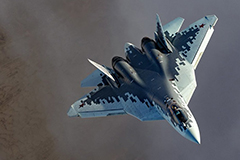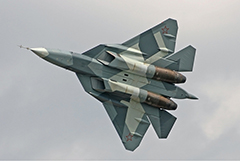Sukhoi Su-57 Fighter Jet
The Sukhoi Su-57 is the designation for a stealth, single-seat, twin-engine multirole fifth-generation jet fighter being developed for air superiority and attack operations. The aircraft is the product of the PAK FA, a fifth-generation fighter programme of the Russian Air Force. Sukhoi's internal name for the aircraft is T-50. The Su-57 will be the first aircraft in Russian military service to use stealth technology.
 The fighter is designed to have supercruise, supermaneuverability, stealth, and advanced avionics to overcome the prior generation fighter aircraft as well as ground and naval defences. The Su-57 is intended to succeed the MiG-29 and Su-27 in the Russian Air Force.
The fighter is designed to have supercruise, supermaneuverability, stealth, and advanced avionics to overcome the prior generation fighter aircraft as well as ground and naval defences. The Su-57 is intended to succeed the MiG-29 and Su-27 in the Russian Air Force.
The prototypes and initial production batch are to be delivered with a highly upgraded variant of the Lyulka AL-31 engine used by the Su-27 family as interim powerplant while an advanced clean-sheet design engine, the Saturn izdeliye 30, is currently under development. The aircraft is expected to have a service life of up to 35 years. Its first flight took place on 29 January 2010.
The Su-57 will be a fifth-generation multirole fighter aircraft and the first operational stealth aircraft for the Russian Air Force. Although most information is classified, sources within the Sukhoi company and Defence Ministry have openly stated that the aircraft is to be stealthy, supermaneuverable, have supercruise capability, incorporate substantial amounts of composite materials, and possess advanced avionics such as active phased-array radar and sensor fusion.
The Su-57 has a blended wing body fuselage and incorporates all-moving horizontal and vertical stabilizers; the vertical stabilizers toe inwards to serve as the aircraft's airbrake. The aircraft incorporates thrust vectoring and has adjustable leading–edge vortex controllers (LEVCONs) designed to control vortices generated by the leading edge root extensions, and can provide trim and improve high angle of attack behaviour, including a quick stall recovery if the thrust vectoring system fails.
The advanced flight control system and thrust vectoring nozzles make the aircraft departure-resistant and highly maneuverable in both pitch and yaw, enabling the aircraft to perform very high angles of attack maneuvers such as the Pugachev's Cobra and the bell maneuver, along with doing flat rotations with little altitude loss. The aircraft's aerodynamics and engines enable it to achieve Mach 2 and is also capable of flying supersonic flight without afterburners, or supercruise; the high cruising speed and normal operating altitude is also expected to give it a significant kinematic advantage over prior generations of aircraft. More details
 The fighter is designed to have supercruise, supermaneuverability, stealth, and advanced avionics to overcome the prior generation fighter aircraft as well as ground and naval defences. The Su-57 is intended to succeed the MiG-29 and Su-27 in the Russian Air Force.
The fighter is designed to have supercruise, supermaneuverability, stealth, and advanced avionics to overcome the prior generation fighter aircraft as well as ground and naval defences. The Su-57 is intended to succeed the MiG-29 and Su-27 in the Russian Air Force.The prototypes and initial production batch are to be delivered with a highly upgraded variant of the Lyulka AL-31 engine used by the Su-27 family as interim powerplant while an advanced clean-sheet design engine, the Saturn izdeliye 30, is currently under development. The aircraft is expected to have a service life of up to 35 years. Its first flight took place on 29 January 2010.
The Su-57 will be a fifth-generation multirole fighter aircraft and the first operational stealth aircraft for the Russian Air Force. Although most information is classified, sources within the Sukhoi company and Defence Ministry have openly stated that the aircraft is to be stealthy, supermaneuverable, have supercruise capability, incorporate substantial amounts of composite materials, and possess advanced avionics such as active phased-array radar and sensor fusion.
The Su-57 has a blended wing body fuselage and incorporates all-moving horizontal and vertical stabilizers; the vertical stabilizers toe inwards to serve as the aircraft's airbrake. The aircraft incorporates thrust vectoring and has adjustable leading–edge vortex controllers (LEVCONs) designed to control vortices generated by the leading edge root extensions, and can provide trim and improve high angle of attack behaviour, including a quick stall recovery if the thrust vectoring system fails.
The advanced flight control system and thrust vectoring nozzles make the aircraft departure-resistant and highly maneuverable in both pitch and yaw, enabling the aircraft to perform very high angles of attack maneuvers such as the Pugachev's Cobra and the bell maneuver, along with doing flat rotations with little altitude loss. The aircraft's aerodynamics and engines enable it to achieve Mach 2 and is also capable of flying supersonic flight without afterburners, or supercruise; the high cruising speed and normal operating altitude is also expected to give it a significant kinematic advantage over prior generations of aircraft. More details

